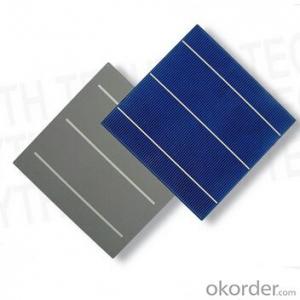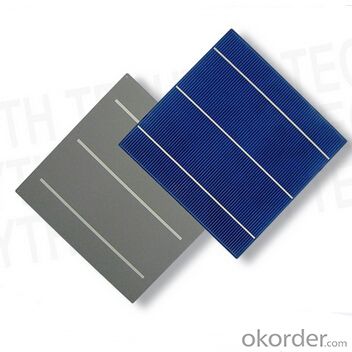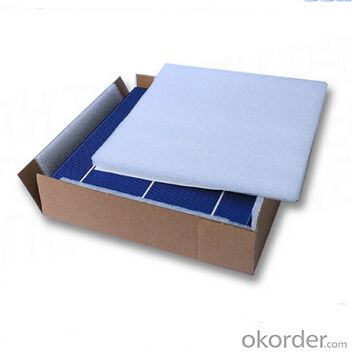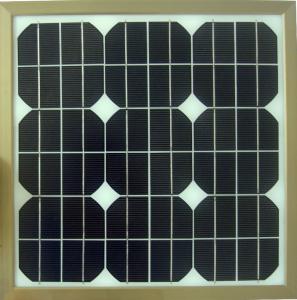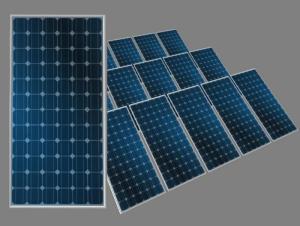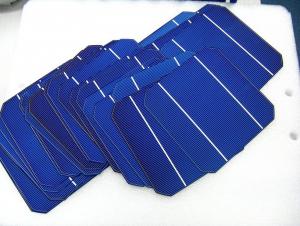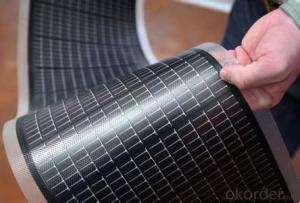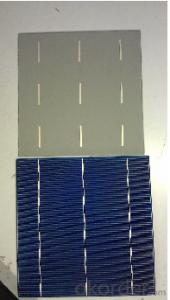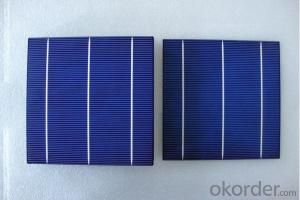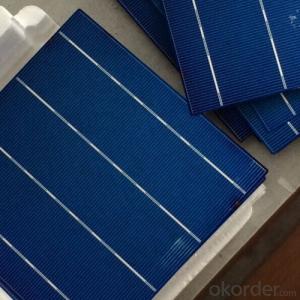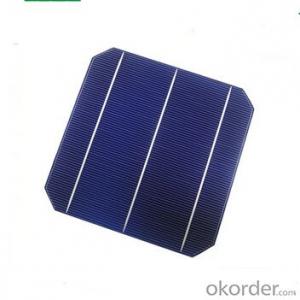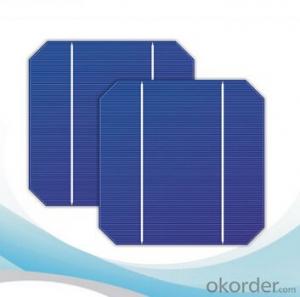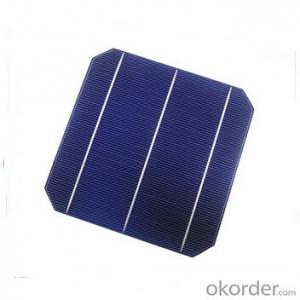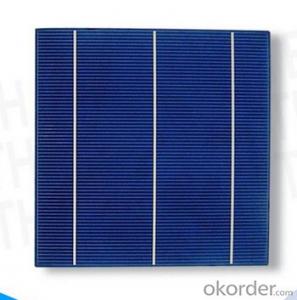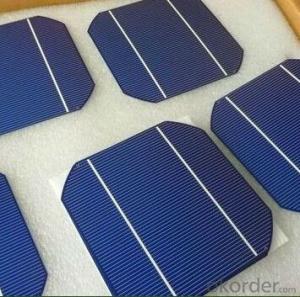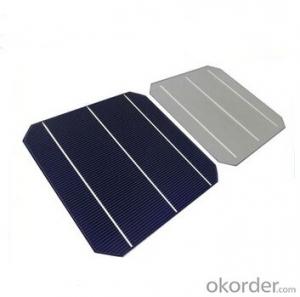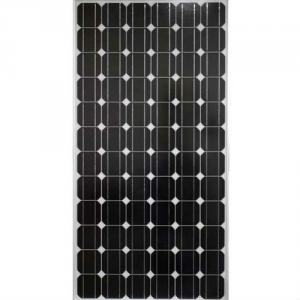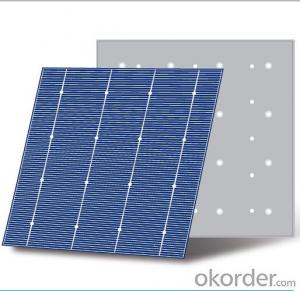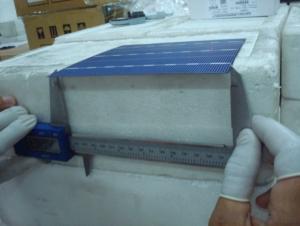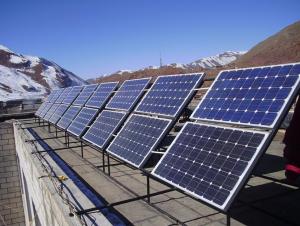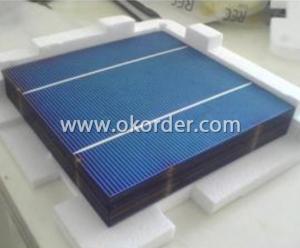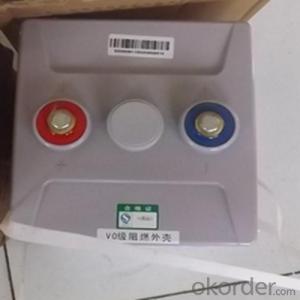Invisible Monocrystalline Solar Cells High Quality 17.00-18.20
- Loading Port:
- Shanghai
- Payment Terms:
- TT OR LC
- Min Order Qty:
- 1000 pc
- Supply Capability:
- 1000000 pc/month
OKorder Service Pledge
OKorder Financial Service
You Might Also Like
Solar Cells:
Solar cells is made by solar wafer, it has three categories of solar cell right now, monocrystalline polycrystalline and thin film,These cells are entirely based around the concept PN junction, which is the critical part of solar module, it is the part that can convert the light energy into electricity, the thickness is from 180um to 200um, with even busbars to conduct electricity, textured cell can decrease diffuse reflection; they are often electrically connected and encapsulated as a module. Photovoltaic modules often have a sheet of glass on the front (sun up) side, allowing light to pass while protecting semiconductor wafers from abrasion and impact due to wind-driven debris, rain, hail, etc. Solar cells are also usually connected in series in modules, creating an additive voltage. Connecting cells in parallel will yield a higher current;With high quality and stable quality. Our Cells can greatly improve the performance of Solar Modules.
Features:
1. High conversion efficiencies resulting in superior power output performance.
2. Outstanding power output even in low light or high temperature conditions
3. Optimized design for ease of soldering and lamination
4. Long-term stability, reliability and performance
5. Low breakage rate
6. Color uniformity
Solar Cells Advantage:
• High efficiency and stable performance in photovoltaic conversion.
• Advanced diffusion technique ensuring the homogeneity of energy conversion efficiency of the cell.
• Advanced PECVD film forming, providing a dark blue silicon nitride anti-reflection film of homogenous color and attractive appearance.
• High quality metal paste for back surface and electrode, ensuring good conductivity, high pulling strength and ease of soldering.
• High precision patterning using screen printing, ensuring accurate busbar location for ease with automatic soldering a laser cutting.
Specifications:
Efficiency code | 182 | 180 | 178 | 176 | 174 | 172 | 170 | |
Efficiency | Eff(%) | 18.20 | 18.00 | 17.80 | 17.60 | 17.40 | 17.20 | 17.00 |
Power | Ppm(W) | 4.43 | 4.38 | 4.33 | 4.28 | 4.23 | 4.19 | 4.14 |
Max. Power current | Ipm(A) | 8.26 | 8.22 | 8.17 | 8.12 | 8.08 | 8.05 | 7.99 |
Short Circut Current | Isc(A) | 8.71 | 8.68 | 8.63 | 8.60 | 8.56 | 8.53 | 8.49 |
Max. Power Voltage | Vpm(V) | 0.536 | 0.533 | 0.530 | 0.527 | 0.524 | 0.521 | 0.518 |
Open Cirtuit Voltage | Voc(V) | 0.634 | 0.632 | 0.630 | 0.627 | 0.625 | 0.622 | 0.620 |
Packaging & Delivery of Solar Cells
Carton Box Package and Deliver by air. It should be noticed that it should be avoid of water, sunshine and moist.
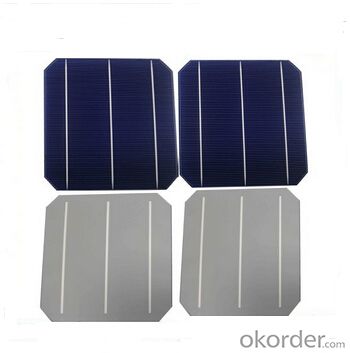
FAQ
We have organized several common questions for our clients,may help you sincerely:
①What price for each watt?
It depends on the efficiency of the solar cell, quantity, delivery date and payment terms.
②How long can we receive the product after purchase?
In the purchase of product within three working days, We will arrange the factory delivery as soon as possible. The pecific time of receiving is related to the state and position of customers.Commonly 7 to 10 working days can be served.
③Can you provide the peripheral products of the solar panels, such as the battery, controller, and inverter? If so, can you tell me how do they match each other?
Yes, we can, we have two companies for solar region, one is CNBM International, the other is CNBM engineering Co.
We can provide you not only the solar module but also the off grid solar system, we can also provide you service with on grid plant.
④What is your warranty of solar cell?
Our product can promise lower than 0.3% open box crack, we support claim after opening the box if it has crackm color difference or sth, the buyer should give pictures immediately, we can not accept the claim after the solar cell has assembled to solar panel.
• Timeliness of delivery
• ⑤How do you pack your products?
We have rich experience on how to pack the solar cell to make sure the safety on shipment, we could use wooden box or pallet as buyer's preference.
- Q: Can solar cells be damaged by hail or other weather events?
- Yes, solar cells can be damaged by hail or other severe weather events. Hailstones, strong winds, and heavy debris can crack or break the delicate glass surface of solar panels, reducing their efficiency or rendering them completely non-functional. Therefore, it is important to consider the durability and quality of solar panels when installing them in areas prone to such weather conditions.
- Q: What is the role of solar cells in powering remote monitoring systems?
- Solar cells play a crucial role in powering remote monitoring systems by converting sunlight into electricity. These systems are often installed in remote locations where access to traditional power sources is limited or non-existent. Solar cells provide a sustainable and reliable source of energy to continuously power these systems, allowing for continuous monitoring and data collection even in remote areas.
- Q: How long does it take to install solar cells on a residential property?
- The installation of solar cells on a residential property typically takes a few days to a few weeks, depending on various factors such as the size of the system, the complexity of the installation, and the availability of the installation team.
- Q: What is the payback period for installing solar cells?
- The payback period for installing solar cells varies depending on several factors, such as the initial cost of installation, the amount of energy generated by the solar cells, and the cost of electricity in the area. Generally, the payback period ranges from 5 to 15 years, but it can be shorter or longer depending on these factors.
- Q: Can solar cells be used in countries with limited sunlight?
- Yes, solar cells can still be used in countries with limited sunlight. While solar cells are most efficient in areas with abundant sunlight, they can still generate electricity even in regions with limited sunlight. Advances in technology have made solar cells more efficient and capable of capturing and converting sunlight into electricity even in low-light conditions. Additionally, solar cells can be combined with battery storage systems to store excess energy generated during sunny periods for use during cloudy or nighttime hours. Thus, solar cells can be a viable and sustainable energy solution in countries with limited sunlight.
- Q: I know that solar cells are produced by DC and then converted into alternating current through the inverter, who explains why the solar cell is produced by DC?
- The sun is irradiated on the semiconductor p-n junction to form a new hole-electron pair. Under the action of the p-n junction electric field, the holes flow from the n region to the p region.
- Q: What is the role of voltage regulators in solar cell systems?
- The role of voltage regulators in solar cell systems is to regulate and control the voltage output from the solar panels to ensure it remains within a specific range that is suitable for the connected devices or batteries. This helps prevent overcharging, which can damage the devices or batteries, and ensures optimal performance and efficiency of the solar cell system.
- Q: What are the disadvantages of using solar cells?
- One disadvantage of using solar cells is their high initial cost. The installation and setup of solar panels can be expensive, making it less accessible for some individuals or households. Additionally, solar cells are dependent on sunlight, so their efficiency can be affected by weather conditions, such as cloudy days or limited sunlight during winter months. Moreover, the production of solar cells involves the use of certain materials that can have environmental impacts, such as the extraction of rare minerals. However, advancements in technology and decreasing costs are gradually reducing these disadvantages and making solar energy a more viable option for sustainable energy production.
- Q: Can solar cells be used for powering electric vehicle charging stations?
- Yes, solar cells can be used to power electric vehicle charging stations. Solar panels can generate electricity from sunlight, which can then be used to charge electric vehicles. This not only promotes the use of renewable energy but also reduces the carbon footprint of electric vehicles by eliminating the need for grid electricity.
- Q: How is the efficiency of a solar cell calculated?
- The efficiency of a solar cell is calculated by dividing the maximum power output of the cell by the input power from the sunlight.
Send your message to us
Invisible Monocrystalline Solar Cells High Quality 17.00-18.20
- Loading Port:
- Shanghai
- Payment Terms:
- TT OR LC
- Min Order Qty:
- 1000 pc
- Supply Capability:
- 1000000 pc/month
OKorder Service Pledge
OKorder Financial Service
Similar products
Hot products
Hot Searches
Related keywords
